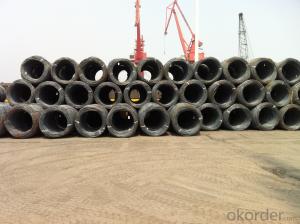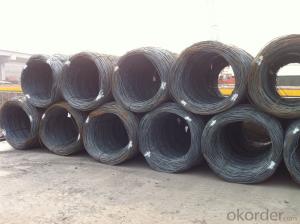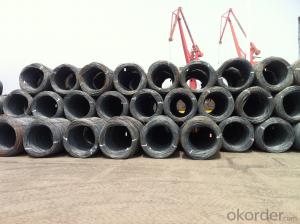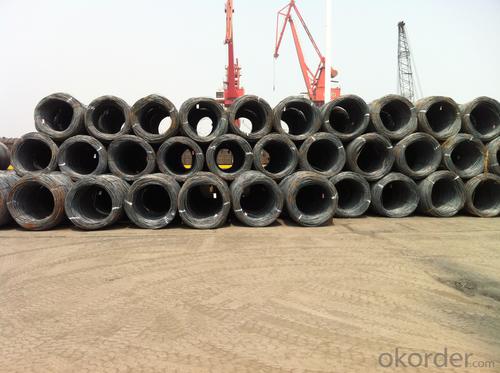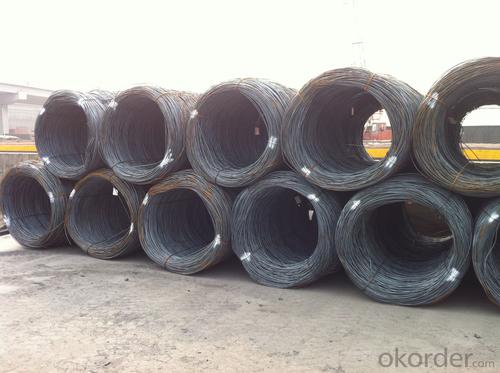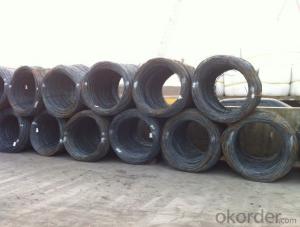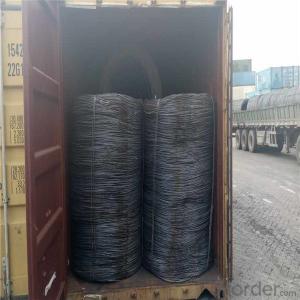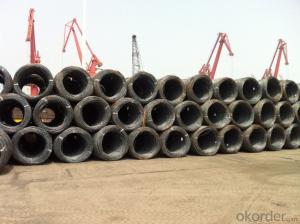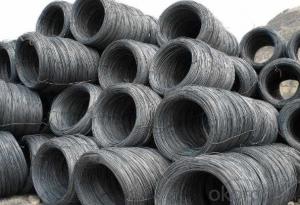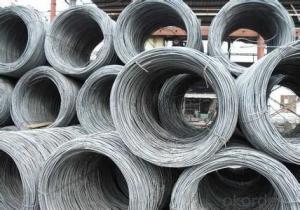Wire rod SAE 1006-1018 with Best Quality and Lowest Price
- Loading Port:
- Tianjin
- Payment Terms:
- TT OR LC
- Min Order Qty:
- 25 m.t
- Supply Capability:
- 20000 m.t/month
OKorder Service Pledge
OKorder Financial Service
You Might Also Like
Specification
OKorder is offering Hot Rolled Carbon Steel Wire Rod 5.5mm with High Quality at great prices with worldwide shipping. Our supplier is a world-class manufacturer of steel, with our products utilized the world over. OKorder annually supplies products to European, North American and Asian markets. We provide quotations within 24 hours of receiving an inquiry and guarantee competitive prices.
Product Applications:
Hot Rolled Carbon Steel Wire Rod 5.5mm with High Quality is widely used in construction and manufacturing. Carbon steel wire rod is mainly used for reinforcement of reinforced concrete and welded structure or reprocessed (roberts , nail, etc.) materials, especially used to produce wire drawing, welding electrode, nails, spring, electronic, precise machinery parts and so on.
Product Advantages:
OKorder's Hot Rolled Carbon Steel Wire Rod are durable, strong.packed and suitable for wire mesh,nail manufacture and construction
Main Product Features:
· Premium quality
· Prompt delivery & seaworthy packing (30 days after receiving deposit)
· Can be recycled and reused
· Mill test certification
· Professional Service
· Competitive pricing
Product Specifications:
Manufacture: Hot rolled
Grade: SAE1006 SAE1008 SAE1010 SAE1012 SAE1016 SAE1018
Certificates: ISO, SGS, BV, CIQ
Weight per Coil:2-2.05tons
Packaging: Export packing, packed by coil
Grade | Chemical Composition (%) | |||||
C | Mn | S | P | Si | B | |
SAE1006B | 0.03~O.07 | 0.32max | 0.045max | 0.040max | 0.30max | 0.0008min |
Mechanical properties | ||||||
Yield strength(N/mm2) | Tensile strength(N/mm2) | Elongation (%) | ||||
250-280 | 350-380 | ≥32 | ||||
Grade | Chemical Composition (%) | |||||
C | Mn | S | P | Si | B | |
SAE1008B | 0.10max | 0.3~0.50 | 0.050max | 0.040 max | 0.15max | 0.0008 min |
Mechanical properties | ||||||
Yield strength(N/mm2) | Tensile strength(N/mm2) | Elongation (%) | ||||
≥195 | 315-430 | ≥30 | ||||
FAQ:
Q1: Why buy Materials & Equipment from OKorder.com?
A1: All products offered byOKorder.com are carefully selected from China's most reliable manufacturing enterprises. Through its ISO certifications, OKorder.com adheres to the highest standards and a commitment to supply chain safety and customer satisfaction.
Q2: How do we guarantee the quality of our products?
A2: We have established an advanced quality management system which conducts strict quality tests at every step, from raw materials to the final product. At the same time, we provide extensive follow-up service assurances as required.
Q3: How soon we can delivery the goods ?
A3: We have a mill with 20000mts of capacity per month. We can delivery the goods within in one month ,as long as your order quantity less than 20000mts
Q4:What's your payment terms ?
A4:Mostly,we collect the money by T/T and LC at sight . We also accept time LC at 90/120 days sight.
Image:
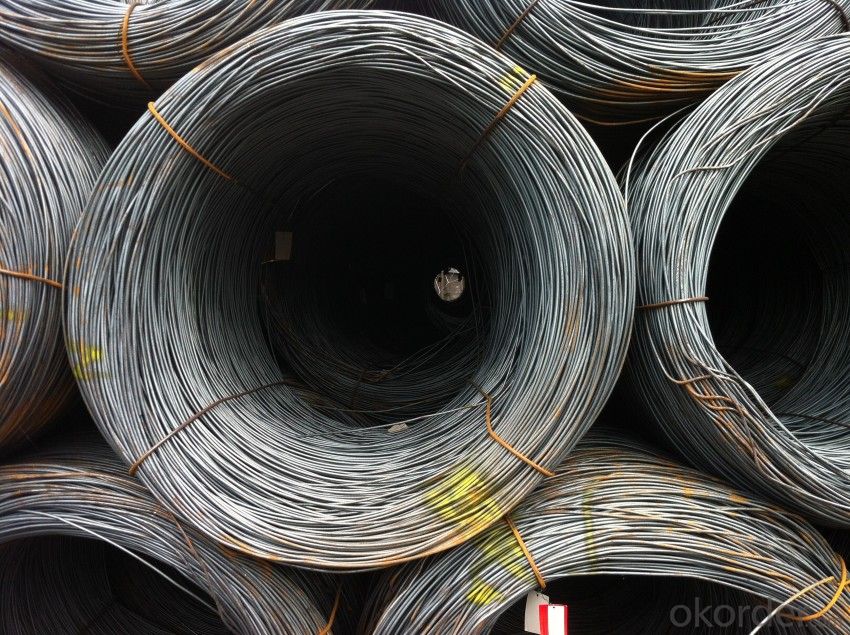
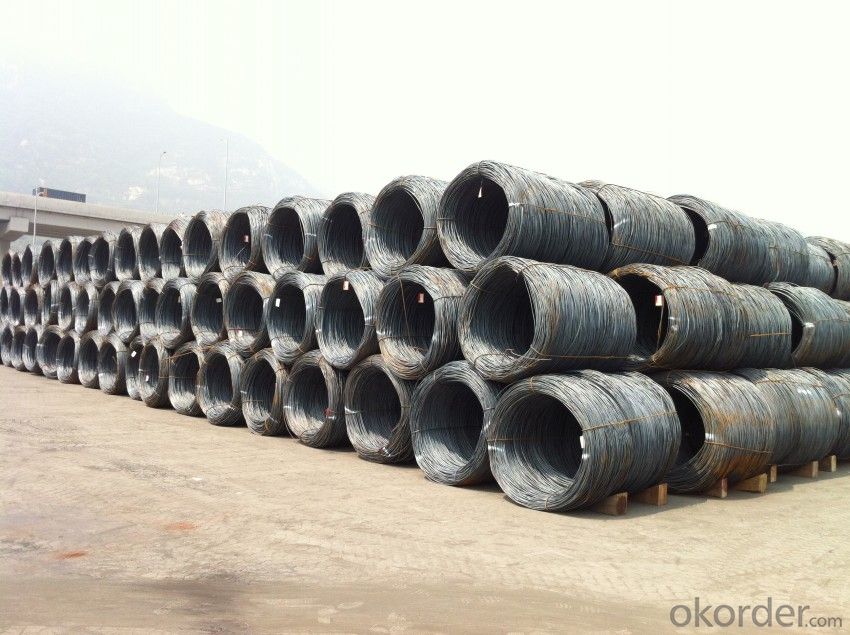
- Q: How is steel wire rod used in the manufacturing of wire forms for material handling?
- Steel wire rod is used in the manufacturing of wire forms for material handling as it provides the necessary strength and durability required for handling heavy loads. The wire rod is first processed through various shaping and forming techniques, such as bending, cutting, and welding, to create the desired wire forms. These wire forms are then incorporated into material handling equipment such as baskets, racks, hooks, and frames to safely and securely hold and transport materials. The high tensile strength of steel wire rod ensures that the wire forms can withstand the stress and strain of material handling operations, making it an essential component in this manufacturing process.
- Q: What are the standard fatigue resistance requirements for steel wire rod?
- The fatigue resistance requirements for steel wire rods vary depending on the specific application and industry standards. However, there are some general guidelines that can be taken into consideration. Industries such as automotive, aerospace, and construction place great importance on fatigue resistance when it comes to steel wire rods. These rods experience cyclic loading and stress, which can result in fatigue failure if the material is not designed to withstand these conditions. Fatigue tests, such as rotating bending or axial fatigue tests, are typically used to determine the fatigue resistance requirements for steel wire rods. These tests subject the wire rod to repeated cycles of loading and unloading under specific conditions, such as stress amplitude and frequency. Parameters such as fatigue strength, fatigue life, and fatigue limit are often used to quantify the fatigue resistance of steel wire rods. Fatigue strength represents the maximum stress level that the wire rod can endure for a specified number of cycles without failure. Fatigue life indicates the number of cycles that the wire rod can sustain before failure occurs. The fatigue limit, also known as endurance limit, is the stress level below which the wire rod can theoretically endure an infinite number of cycles without failure. The specific fatigue resistance requirements for steel wire rods can vary based on factors such as the intended use, material composition, and expected service life. These requirements are typically defined by industry standards and specifications, such as those established by organizations like ASTM or ISO. Manufacturers and engineers must carefully consider the fatigue resistance requirements for steel wire rods to ensure the safety and reliability of the final products. This involves selecting the appropriate material grade, conducting thorough testing and analysis, and adhering to industry standards and specifications.
- Q: What are the major steel wire rod consuming industries?
- The major steel wire rod consuming industries include construction, automotive, manufacturing, infrastructure, and energy sectors.
- Q: What are the main factors influencing the choice of steel wire rod order tracking system?
- The choice of a steel wire rod order tracking system is influenced by several key factors. Firstly, the size and complexity of the steel wire rod order tracking system is an important consideration. If the company deals with a high volume of orders, a more advanced and sophisticated tracking system may be necessary to efficiently manage and track all the orders. On the other hand, if the company has a smaller number of orders, a simpler tracking system may be sufficient. Secondly, the specific requirements and needs of the company play a crucial role in determining the choice of order tracking system. Different companies may have different priorities and objectives, such as reducing lead times, improving accuracy, or enhancing customer satisfaction. The tracking system should align with these goals and effectively address the specific needs of the company. Thirdly, the integration and compatibility of the tracking system with existing systems and processes is an important factor. The order tracking system should seamlessly integrate with other systems and processes within the company, such as inventory management, production planning, and customer relationship management. This ensures smooth operations and avoids any disruption or duplication of efforts. Additionally, the scalability and flexibility of the order tracking system are significant considerations. As the company grows and expands, the tracking system should be able to accommodate increasing order volumes and changing requirements. It should be easily scalable and adaptable to meet the evolving needs of the business. Furthermore, the cost and return on investment of the order tracking system are important factors. The system should provide value for money and offer a positive return on investment by improving efficiency, reducing errors, and enhancing customer satisfaction. It is essential to assess the upfront and ongoing costs of implementing and maintaining the system, and weigh them against the potential benefits. Lastly, the availability of technical support and training is a crucial factor. The chosen tracking system should be supported by a reliable and responsive technical support team, who can promptly address any issues or concerns. Additionally, the system should come with comprehensive training and documentation to ensure that the company's employees can effectively utilize and maximize the benefits of the system. In conclusion, the main factors influencing the choice of a steel wire rod order tracking system include the size and complexity of the system, specific requirements and needs of the company, integration and compatibility with existing systems, scalability and flexibility, cost and return on investment, and availability of technical support and training. By considering these factors, a company can make an informed decision and select the most suitable order tracking system for their operations.
- Q: How is steel wire rod used in the production of tire reinforcement materials for motorcycles?
- Steel wire rod is used in the production of tire reinforcement materials for motorcycles as it provides strength and durability. The steel wire rod is typically woven into a mesh or used as individual strands, which are then incorporated into the tire's structure to enhance its structural integrity and resistance to punctures and impacts. This reinforcement ensures that the motorcycle tires maintain their shape, grip the road effectively, and provide a safe and reliable riding experience.
- Q: What are the main factors affecting the market trust of steel wire rod?
- The main factors affecting the market trust of steel wire rod include product quality and reliability, adherence to industry standards and regulations, the reputation and track record of the manufacturer, transparent and ethical business practices, consistent and timely delivery, competitive pricing, and customer satisfaction.
- Q: How does the ductility of steel wire rod vary with different heat treatment processes?
- The ductility of steel wire rod can vary with different heat treatment processes. Heat treatment processes such as annealing and tempering can improve the ductility of steel wire rod by reducing its hardness and increasing its flexibility. On the other hand, processes like quenching and martempering can decrease the ductility of steel wire rod by increasing its hardness and brittleness. Therefore, the specific heat treatment process chosen can significantly affect the ductility of steel wire rod.
- Q: What are the common industry trends for steel wire rod?
- Some common industry trends for steel wire rod include increasing demand from the construction and automotive sectors, advancements in technology leading to improved product quality and efficiency, growing emphasis on sustainability and recycling practices, and the emergence of new markets and applications for steel wire rod products.
- Q: What are the common production processes for silver-coated steel wire rod?
- The common production processes for silver-coated steel wire rod include wire drawing, cleaning, coating, drying, and packaging.
- Q: What are the different types of steel wire rod dimensional inspection methods?
- There are several different types of steel wire rod dimensional inspection methods that are commonly used in the industry. These methods are employed to ensure that the dimensions of the steel wire rods meet the specified requirements and are suitable for their intended applications. Some of the main dimensional inspection methods include: 1. Caliper measurement: This is a basic but effective method that involves using a caliper tool to measure the diameter of the steel wire rod. The caliper provides a quick and easy way to obtain accurate measurements. 2. Micrometer measurement: Micrometers are commonly used for precision measurements in the steel industry. They provide a more accurate measurement than calipers and are typically used to measure the diameter of the wire rod. 3. Optical measurement: Optical measurement methods utilize cameras, lasers, or other optical devices to capture images or collect data about the dimensions of the steel wire rod. These methods can be non-contact and provide high precision measurements. 4. Laser scanning: Laser scanning technology is commonly used to measure the profile or shape of steel wire rods. It involves scanning a laser beam across the surface of the wire rod and capturing the reflected beam to determine the dimensions. 5. Ultrasonic measurement: Ultrasonic measurement methods use sound waves to measure the dimensions of the steel wire rod. Ultrasonic waves are sent through the material, and the time it takes for the waves to bounce back is measured to determine the dimensions. 6. Coordinate measuring machine (CMM): CMMs are advanced measurement systems that use probes and computer software to measure the dimensions of the steel wire rod. They can provide highly accurate and precise measurements. 7. Visual inspection: Visual inspection is a simple method that involves visually examining the steel wire rod for any visual defects or deviations from the specified dimensions. This method is often used as a preliminary inspection before employing more advanced measurement techniques. These are just a few of the various methods used to inspect the dimensions of steel wire rods. Each method has its own advantages and limitations, and the choice of the appropriate method depends on factors such as the required level of accuracy, the complexity of the wire rod's shape, and the available resources and equipment.
Send your message to us
Wire rod SAE 1006-1018 with Best Quality and Lowest Price
- Loading Port:
- Tianjin
- Payment Terms:
- TT OR LC
- Min Order Qty:
- 25 m.t
- Supply Capability:
- 20000 m.t/month
OKorder Service Pledge
OKorder Financial Service
Similar products
Hot products
Hot Searches
Related keywords
